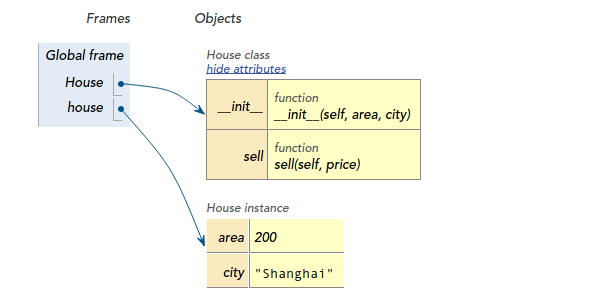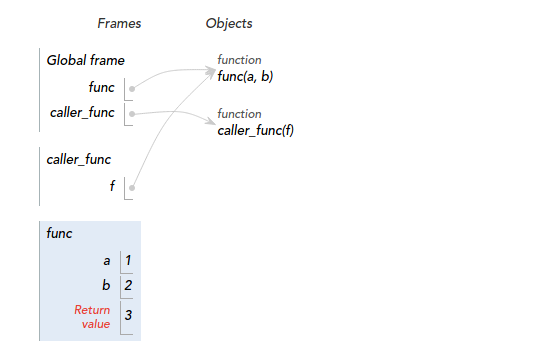python 装饰器
来源:互联网 发布:string数组去掉空格 编辑:程序博客网 时间:2024/05/07 00:59
“在Python中,函数本身也是对象”这一本质。那不妨慢慢来,从最基本的概念开始,讨论一下这个问题:
1. Python中一切皆对象
这恐怕是学习Python最有用的一句话。想必你已经知道Python中的list, tuple, dict等内置数据结构,当你执行:
alist = [1, 2, 3]时,你就创建了一个列表对象,并且用alist这个变量引用它:
<img src="https://pic2.zhimg.com/d19b60d824c68780fd863c32fb46226d_b.jpg" data-rawwidth="460" data-rawheight="147" class="origin_image zh-lightbox-thumb" width="460" data-original="https://pic2.zhimg.com/d19b60d824c68780fd863c32fb46226d_r.jpg">当然你也可以自己定义一个类:
 当然你也可以自己定义一个类:
当然你也可以自己定义一个类:class House(object): def __init__(self, area, city): self.area = area self.city = city def sell(self, price): [...] #other code return price然后创建一个类的对象:
house = House(200, 'Shanghai')OK,你立马就在上海有了一套200平米的房子,它有一些属性(area, city),和一些方法(__init__, self):
<img src="https://pic2.zhimg.com/5f96cfc3c50822c7f838849a27421805_b.jpg" data-rawwidth="592" data-rawheight="306" class="origin_image zh-lightbox-thumb" width="592" data-original="https://pic2.zhimg.com/5f96cfc3c50822c7f838849a27421805_r.jpg">

2. 函数是第一类对象
和list, tuple, dict以及用House创建的对象一样,当你定义一个函数时,函数也是对象:
def func(a, b): return a+b 在全局域,函数对象被函数名引用着,它接收两个参数a和b,计算这两个参数的和作为返回值。
在全局域,函数对象被函数名引用着,它接收两个参数a和b,计算这两个参数的和作为返回值。所谓第一类对象,意思是可以用标识符给对象命名,并且对象可以被当作数据处理,例如赋值、作为参数传递给函数,或者作为返回值return 等
因此,你完全可以用其他变量名引用这个函数对象:
add = func<img src="https://pic4.zhimg.com/c45b67c3f4394d4296415730eacf186b_b.jpg" data-rawwidth="434" data-rawheight="174" class="origin_image zh-lightbox-thumb" width="434" data-original="https://pic4.zhimg.com/c45b67c3f4394d4296415730eacf186b_r.jpg">这样,你就可以像调用func(1, 2)一样,通过新的引用调用函数了:
 这样,你就可以像调用func(1, 2)一样,通过新的引用调用函数了:
这样,你就可以像调用func(1, 2)一样,通过新的引用调用函数了:print func(1, 2)print add(1, 2) #the same as func(1, 2)
或者将函数对象作为参数,传递给另一个函数:
def caller_func(f): return f(1, 2)if __name__ == "__main__": print caller_func(func)<img src="https://pic2.zhimg.com/12e1beef560929ed34f1b9f075109e31_b.jpg" data-rawwidth="549" data-rawheight="358" class="origin_image zh-lightbox-thumb" width="549" data-original="https://pic2.zhimg.com/12e1beef560929ed34f1b9f075109e31_r.jpg">

可以看到,
- 函数对象func作为参数传递给caller_func函数,传参过程类似于一个赋值操作f=func;
- 于是func函数对象,被caller_func函数作用域中的局部变量f引用,f实际指向了函数func;cc
- 当执行return f(1, 2)的时候,相当于执行了return func(1, 2);
3. 函数对象 vs 函数调用
无论是把函数赋值给新的标识符,还是作为参数传递给新的函数,针对的都是函数对象本身,而不是函数的调用。
用一个更加简单,但从外观上看,更容易产生混淆的例子来说明这个问题。例如定义了下面这个函数:
def func(): return "hello,world"然后分别执行两次赋值:
ref1 = func #将函数对象赋值给ref1ref2 = func() #调用函数,将函数的返回值("hello,world"字符串)赋值给ref2很多初学者会混淆这两种赋值,通过Python内建的type函数,可以查看一下这两次赋值的结果:
In [4]: type(ref1)Out[4]: functionIn [5]: type(ref2)Out[5]: str可以看到,ref1引用了函数对象本身,而ref2则引用了函数的返回值。通过内建的callable函数,可以进一步验证ref1是可调用的,而ref2是不可调用的:
In [9]: callable(ref1)Out[9]: TrueIn [10]: callable(ref2)Out[10]: False传参的效果与之类似。
4. 闭包&LEGB法则
所谓闭包,就是将组成函数的语句和这些语句的执行环境打包在一起时,得到的对象
听上去的确有些复杂,还是用一个栗子来帮助理解一下。假设我们在foo.py模块中做了如下定义:
#foo.pyfilename = "foo.py"def call_func(f): return f() #如前面介绍的,f引用一个函数对象,然后调用它在另一个func.py模块中,写下了这样的代码:
#func.pyimport foo #导入foo.pyfilename = "func.py"def show_filename(): return "filename: %s" % filenameif __name__ == "__main__": print foo.call_func(show_filename) #注意:实际发生调用的位置,是在foo.call_func函数中当我们用python func.py命令执行func.py时输出结果为:
chiyu@chiyu-PC:~$ python func.py filename:func.py很显然show_filename()函数使用的filename变量的值,是在与它相同环境(func.py模块)中定义的那个。尽管foo.py模块中也定义了同名的filename变量,而且实际调用show_filename的位置也是在foo.py的call_func内部。
而对于嵌套函数,这一机制则会表现的更加明显:闭包将会捕捉内层函数执行所需的整个环境:
#enclosed.pyimport foodef wrapper(): filename = "enclosed.py" def show_filename(): return "filename: %s" % filename print foo.call_func(show_filename) #输出:filename: enclosed.py实际上,每一个函数对象,都有一个指向了该函数定义时所在全局名称空间的__globals__属性:
#show_filename inside wrapper#show_filename.__globals__{'__builtins__': <module '__builtin__' (built-in)>, #内建作用域环境'__file__': 'enclosed.py', 'wrapper': <function wrapper at 0x7f84768b6578>, #直接外围环境'__package__': None, '__name__': '__main__', 'foo': <module 'foo' from '/home/chiyu/foo.pyc'>, #全局环境'__doc__': None }当代码执行到show_filename中的return "filename: %s" % filename语句时,解析器按照下面的顺序查找filename变量:
- Local - 本地函数(show_filename)内部,通过任何方式赋值的,而且没有被global关键字声明为全局变量的filename变量;
- Enclosing - 直接外围空间(上层函数wrapper)的本地作用域,查找filename变量(如果有多层嵌套,则由内而外逐层查找,直至最外层的函数);
- Global - 全局空间(模块enclosed.py),在模块顶层赋值的filename变量;
- Builtin - 内置模块(__builtin__)中预定义的变量名中查找filename变量;
总结:
- 闭包最重要的使用价值在于:封存函数执行的上下文环境;
- 闭包在其捕捉的执行环境(def语句块所在上下文)中,也遵循LEGB规则逐层查找,直至找到符合要求的变量,或者抛出异常。
5. 装饰器&语法糖(syntax sugar)
那么闭包和装饰器又有什么关系呢?
上文提到闭包的重要特性:封存上下文,这一特性可以巧妙的被用于现有函数的包装,从而为现有函数更加功能。而这就是装饰器。
还是举个例子,代码如下:
#alist = [1, 2, 3, ..., 100] --> 1+2+3+...+100 = 5050def lazy_sum(): return reduce(lambda x, y: x+y, alist)我们定义了一个函数lazy_sum,作用是对alist中的所有元素求和后返回。alist假设为1到100的整数列表:
alist = range(1, 101)但是出于某种原因,我并不想马上返回计算结果,而是在之后的某个地方,通过显示的调用输出结果。于是我用一个wrapper函数对其进行包装:
def wrapper(): alist = range(1, 101) def lazy_sum(): return reduce(lambda x, y: x+y, alist) return lazy_sumlazy_sum = wrapper() #wrapper() 返回的是lazy_sum函数对象if __name__ == "__main__": lazy_sum() #5050这是一个典型的Lazy Evaluation的例子。我们知道,一般情况下,局部变量在函数返回时,就会被垃圾回收器回收,而不能再被使用。但是这里的alist却没有,它随着lazy_sum函数对象的返回被一并返回了(这个说法不准确,实际是包含在了lazy_sum的执行环境中,通过__globals__),从而延长了生命周期。
当在if语句块中调用lazy_sum()的时候,解析器会从上下文中(这里是Enclosing层的wrapper函数的局部作用域中)找到alist列表,计算结果,返回5050。
当你需要动态的给已定义的函数增加功能时,比如:参数检查,类似的原理就变得很有用:
def add(a, b): return a+b这是很简单的一个函数:计算a+b的和返回,但我们知道Python是 动态类型+强类型 的语言,你并不能保证用户传入的参数a和b一定是两个整型,他有可能传入了一个整型和一个字符串类型的值:
In [2]: add(1, 2)Out[2]: 3In [3]: add(1.2, 3.45)Out[3]: 4.65In [4]: add(5, 'hello')---------------------------------------------------------------------------TypeError Traceback (most recent call last)/home/chiyu/<ipython-input-4-f2f9e8aa5eae> in <module>()----> 1 add(5, 'hello')/home/chiyu/<ipython-input-1-02b3d3d6caec> in add(a, b) 1 def add(a, b):----> 2 return a+bTypeError: unsupported operand type(s) for +: 'int' and 'str'于是,解析器无情的抛出了一个TypeError异常。
动态类型:在运行期间确定变量的类型,python确定一个变量的类型是在你第一次给他赋值的时候;
强类型:有强制的类型定义,你有一个整数,除非显示的类型转换,否则绝不能将它当作一个字符串(例如直接尝试将一个整型和一个字符串做+运算);
因此,为了更加优雅的使用add函数,我们需要在执行+运算前,对a和b进行参数检查。这时候装饰器就显得非常有用:
import logginglogging.basicConfig(level = logging.INFO)def add(a, b): return a + bdef checkParams(fn): def wrapper(a, b): if isinstance(a, (int, float)) and isinstance(b, (int, float)): #检查参数a和b是否都为整型或浮点型 return fn(a, b) #是则调用fn(a, b)返回计算结果 #否则通过logging记录错误信息,并友好退出 logging.warning("variable 'a' and 'b' cannot be added") return return wrapper #fn引用add,被封存在闭包的执行环境中返回if __name__ == "__main__": #将add函数对象传入,fn指向add #等号左侧的add,指向checkParams的返回值wrapper add = checkParams(add) add(3, 'hello') #经过类型检查,不会计算结果,而是记录日志并退出注意checkParams函数:
- 首先看参数fn,当我们调用checkParams(add)的时候,它将成为函数对象add的一个本地(Local)引用;
- 在checkParams内部,我们定义了一个wrapper函数,添加了参数类型检查的功能,然后调用了fn(a, b),根据LEGB法则,解释器将搜索几个作用域,并最终在(Enclosing层)checkParams函数的本地作用域中找到fn;
- 注意最后的return wrapper,这将创建一个闭包,fn变量(add函数对象的一个引用)将会封存在闭包的执行环境中,不会随着checkParams的返回而被回收;
因此调用add(3, 'hello')将不会返回计算结果,而是打印出日志:
chiyu@chiyu-PC:~$ python func.py WARNING:root:variable 'a' and 'b' cannot be added有人觉得add = checkParams(add)这样的写法未免太过麻烦,于是python提供了一种更优雅的写法,被称为语法糖:
@checkParamsdef add(a, b): return a + b这只是一种写法上的优化,解释器仍然会将它转化为add = checkParams(add)来执行。
6. 回归问题
def addspam(fn): def new(*args): print "spam,spam,spam" return fn(*args) return new@addspamdef useful(a,b): print a**2+b**2首先看第二段代码:
- @addspam装饰器,相当于执行了useful = addspam(useful)。在这里题主有一个理解误区:传递给addspam的参数,是useful这个函数对象本身,而不是它的一个调用结果;
再回到addspam函数体:
- return new 返回一个闭包,fn被封存在闭包的执行环境中,不会随着addspam函数的返回被回收;
- 而fn此时是useful的一个引用,当执行return fn(*args)时,实际相当于执行了return useful(*args);
最后附上一张代码执行过程中的引用关系图,希望能帮助你理解:
&lt;img src="https://pic1.zhimg.com/b5674ca16f72af11d7a1c70602fbfe10_b.jpg" data-rawwidth="1087" data-rawheight="314" class="origin_image zh-lightbox-thumb" width="1087" data-original="https://pic1.zhimg.com/b5674ca16f72af11d7a1c70602fbfe10_r.jpg"&gt;

收藏•没有帮助•举报• 作者保留权利
链接:http://www.zhihu.com/question/26930016/answer/81263287
来源:知乎
著作权归作者所有。商业转载请联系作者获得授权,非商业转载请注明出处。
简单来讲,可以不严谨地把Python的装饰器看做一个包装函数的函数。
比如,有一个函数:
def func(): print 'func() run.'if '__main__' == __name__: func()运行后将输出:
func() run.现在需要在函数运行前后打印一条日志, 但是又不希望或者没有权限修改函数内部的结构, 就可以用到装饰器(decorator):
def log(function): def wrapper(*args, **kwargs): print 'before function [%s()] run.' % function.__name__ rst = function(*args, **kwargs) print 'after function [%s()] run.' % function.__name__ return rst return wrapper @logdef func(): print 'func() run.'if '__main__' == __name__: func()对于原来的函数"func()"并没有做修改,而是给其使用了装饰器log,运行后的输出为:
before function [func()] run.func() run.after function [func()] run.把"@log"放到func()函数定义的地方,相当于执行了如下语句:
func = log(func)因为log()返回了一个函数, 所以原本的func指向了log()返回的函数wrapper。wrapper的参数列表为(*args, **kwargs), 所以其可以接受所有的参数调用, 在wrapper中,先打印了一行
'before function [%s()] run.' % function.__name__
(在Python中函数也是对象,函数的__name__是它的名字),然后执行了原来的函数并记录了返回值,在输出
'after function [%s()] run.' % function.__name__
后返回了函数的执行结果。
如果decorator本身需要传入参数,那就需要编写一个返回decorator的decorator。比如在Flask中:
@app.route('/')def index(): return 'hello, world!'实现如下:
import functoolsdef log(text=''): def decorator(function): @functools.wraps(function) def wrapper(*args, **kwargs): print 'before function [%s()] run, text: [%s].' % (function.__name__, text) rst = function(*args, **kwargs) print 'after function [%s()] run, text: [%s].' % (function.__name__, text) return rst return wrapper return decorator@log('log text')def func(): print 'func() run.'if '__main__' == __name__: func()输出如下:
before function [func()] run, text: [log text].func() run.after function [func()] run, text: [log text].最后脑洞小开一下, 有没有办法实现既支持不带参数(如log), 又支持带参数(如log('text'))的decorator吗?
import functoolsdef log(argument): if not callable(argument): def decorator(function): @functools.wraps(function) def wrapper(*args, **kwargs): print 'before function [%s()] run, text: [%s].' % (function.__name__, text) rst = function(*args, **kwargs) print 'after function [%s()] run, text: [%s].' % (function.__name__, text) return rst return wrapper return decorator def wrapper(*args, **kwargs): print 'before function [%s()] run.' % function.__name__ rst = argument(*args, **kwargs) print 'after function [%s()] run.' % function.__name__ return rst return wrapper如上~~~
这是在Python学习小组上介绍的内容,现学现卖、多练习是好的学习方式。
第一步:最简单的函数,准备附加额外功能
# -*- coding:gbk -*-'''示例1: 最简单的函数,表示调用了两次'''def myfunc(): print("myfunc() called.")myfunc()myfunc()
第二步:使用装饰函数在函数执行前和执行后分别附加额外功能
# -*- coding:gbk -*-'''示例2: 替换函数(装饰)装饰函数的参数是被装饰的函数对象,返回原函数对象装饰的实质语句: myfunc = deco(myfunc)'''def deco(func): print("before myfunc() called.") func() print(" after myfunc() called.") return funcdef myfunc(): print(" myfunc() called.")myfunc= deco(myfunc)myfunc()myfunc()第三步:使用语法糖@来装饰函数
# -*- coding:gbk -*-'''示例3: 使用语法糖@来装饰函数,相当于“myfunc = deco(myfunc)”但发现新函数只在第一次被调用,且原函数多调用了一次'''def deco(func): print("before myfunc() called.") func() print(" after myfunc() called.") return func@decodef myfunc(): print(" myfunc() called.")myfunc()myfunc()第四步:使用内嵌包装函数来确保每次新函数都被调用
# -*- coding:gbk -*-'''示例4: 使用内嵌包装函数来确保每次新函数都被调用,内嵌包装函数的形参和返回值与原函数相同,装饰函数返回内嵌包装函数对象'''def deco(func): def _deco(): print("before myfunc() called.") func() print(" after myfunc() called.") # 不需要返回func,实际上应返回原函数的返回值 return _deco@decodef myfunc(): print(" myfunc() called.") return 'ok'myfunc()myfunc()第五步:对带参数的函数进行装饰
# -*- coding:gbk -*-'''示例5: 对带参数的函数进行装饰,内嵌包装函数的形参和返回值与原函数相同,装饰函数返回内嵌包装函数对象'''def deco(func): def _deco(a, b): print("before myfunc() called.") ret= func(a, b) print(" after myfunc() called. result: %s" % ret) return ret return _deco@decodef myfunc(a, b): print(" myfunc(%s,%s) called." % (a, b)) return a+ bmyfunc(1,2)myfunc(3,4)第六步:对参数数量不确定的函数进行装饰
# -*- coding:gbk -*-'''示例6: 对参数数量不确定的函数进行装饰,参数用(*args, **kwargs),自动适应变参和命名参数'''def deco(func): def _deco(*args,**kwargs): print("before %s called." % func.__name__) ret= func(*args,**kwargs) print(" after %s called. result: %s" % (func.__name__, ret)) return ret return _deco@decodef myfunc(a, b): print(" myfunc(%s,%s) called." % (a, b)) return a+b@decodef myfunc2(a, b, c): print(" myfunc2(%s,%s,%s) called." % (a, b, c)) return a+b+cmyfunc(1,2)myfunc(3,4)myfunc2(1,2,3)myfunc2(3,4,5)第七步:让装饰器带参数
# -*- coding:gbk -*-'''示例7: 在示例4的基础上,让装饰器带参数,和上一示例相比在外层多了一层包装。装饰函数名实际上应更有意义些'''def deco(arg): def _deco(func): def __deco(): print("before %s called [%s]." % (func.__name__, arg)) func() print(" after %s called [%s]." % (func.__name__, arg)) return __deco return _deco@deco("mymodule")def myfunc(): print(" myfunc() called.")@deco("module2")def myfunc2(): print(" myfunc2() called.")myfunc()myfunc2()第八步:让装饰器带 类 参数
# -*- coding:gbk -*-'''示例8: 装饰器带类参数'''class locker: def __init__(self): print("locker.__init__() should be not called.") @staticmethod def acquire(): print("locker.acquire() called.(这是静态方法)") @staticmethod def release(): print(" locker.release() called.(不需要对象实例)")def deco(cls): '''cls 必须实现acquire和release静态方法''' def _deco(func): def __deco(): print("before %s called [%s]." % (func.__name__,cls)) cls.acquire() try: return func() finally: cls.release() return __deco return _deco@deco(locker)def myfunc(): print(" myfunc() called.")myfunc()myfunc()第九步:装饰器带类参数,并分拆公共类到其他py文件中,同时演示了对一个函数应用多个装饰器
# -*- coding:gbk -*-'''mylocker.py: 公共类 for 示例9.py'''class mylocker: def __init__(self): print("mylocker.__init__() called.") @staticmethod def acquire(): print("mylocker.acquire() called.") @staticmethod def unlock(): print(" mylocker.unlock() called.")class lockerex(mylocker): @staticmethod def acquire(): print("lockerex.acquire() called.") @staticmethod def unlock(): print(" lockerex.unlock() called.")def lockhelper(cls): '''cls 必须实现acquire和release静态方法''' def _deco(func): def __deco(*args,**kwargs): print("before %s called." % func.__name__) cls.acquire() try: return func(*args,**kwargs) finally: cls.unlock() return __deco return _deco# -*- coding:gbk -*-'''示例9: 装饰器带类参数,并分拆公共类到其他py文件中同时演示了对一个函数应用多个装饰器'''from mylockerimport *class example: @lockhelper(mylocker) def myfunc(self): print(" myfunc() called.") @lockhelper(mylocker) @lockhelper(lockerex) def myfunc2(self, a, b): print(" myfunc2() called.") return a+ bif __name__=="__main__": a= example() a.myfunc() print(a.myfunc()) print(a.myfunc2(1,2)) print(a.myfunc2(3,4))最后一个函数分析:
def lockhelper(cls): '''cls 必须实现acquire和release静态方法''' def _deco(func): def __deco(*args,**kwargs): print("before %s called." % func.__name__) cls.acquire() try: return func(*args,**kwargs) finally: cls.unlock() return __deco return _deco @lockhelper(mylocker) @lockhelper(lockerex) def myfunc2(self, a, b): print(" myfunc2() called.") return a+ b @lockhelper(lockerex) def myfunc2(self, a, b): print(" myfunc2() called.") return a+ b@lockhelper(mylocker)的修饰,并和mylocker打包在一起,所以这个环境共有三层:下面是参考资料,当初有不少地方没看明白,真正练习后才明白些:
1. Python装饰器学习 http://blog.csdn.net/thy38/article/details/4471421
2. Python装饰器与面向切面编程 http://www.cnblogs.com/huxi/archive/2011/03/01/1967600.html
3. Python装饰器的理解 http://apps.hi.baidu.com/share/detail/17572338
- python装饰器装饰类
- [python]python装饰器
- Python装饰器学习
- Python装饰器
- python 装饰器
- Python装饰器
- python 装饰器 应用
- python 装饰器2
- Python装饰器学习
- python装饰器
- python装饰器
- python 装饰器入门
- python装饰器
- python装饰器
- python 装饰器'@'
- python装饰器
- Python装饰器详解
- python 装饰器
- CSS字体中英文名称对照表
- 两个浮点数的比较:bccomp
- 【LaTeX】E喵的LaTeX新手入门教程(1)准备篇
- Maven错误日志记录(不定期更新)
- 49. Group Anagrams
- python 装饰器
- 从0开始学习 GitHub 系列之「加入 GitHub」
- 请教数据库如何建立多对多关系
- git使用详细介绍
- Android中判断当前API的版本号
- MFC,halcon混合编程 遍历目录文件夹下的图像并显示在对话框上
- ACM 数据结构 线段数 HDU 1166 敌兵布阵
- 【LaTeX】E喵的LaTeX新手入门教程(2)基础排版
- MVC框架


